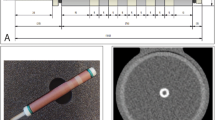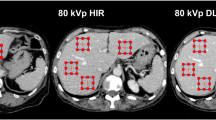Abstract
Objectives
The purpose of this study was to investigate the effects of knowledge-based iterative model reconstruction (IMR) on image quality in cardiac CT performed for the planning of redo cardiac surgery by comparing IMR images with images reconstructed with filtered back-projection (FBP) and hybrid iterative reconstruction (HIR).
Methods
We studied 31 patients (23 men, 8 women; mean age 65.1 ± 16.5 years) referred for redo cardiac surgery who underwent cardiac CT. Paired image sets were created using three types of reconstruction: FBP, HIR, and IMR. Quantitative parameters including CT attenuation, image noise, and contrast-to-noise ratio (CNR) of each cardiovascular structure were calculated. The visual image quality – graininess, streak artefact, margin sharpness of each cardiovascular structure, and overall image quality – was scored on a five-point scale.
Results
The mean image noise of FBP, HIR, and IMR images was 58.3 ± 26.7, 36.0 ± 12.5, and 14.2 ± 5.5 HU, respectively; there were significant differences in all comparison combinations among the three methods. The CNR of IMR images was better than that of FBP and HIR images in all evaluated structures. The visual scores were significantly higher for IMR than for the other images in all evaluated parameters.
Conclusions
IMR can provide significantly improved qualitative and quantitative image quality at in cardiac CT for planning of reoperative cardiac surgery.
Key Points
• Cardiac CT before redo surgery may mitigate increased risk
• Iterative model reconstruction is the next generation in iterative reconstruction
• Iterative model reconstruction improves the image quality in cardiac CT


Similar content being viewed by others
References
Salomon NW, Page US, Bigelow JC, Krause AH, Okies JE, Metzdorff MT (1990) Reoperative coronary surgery. Comparative analysis of 6591 patients undergoing primary bypass and 508 patients undergoing reoperative coronary artery bypass. J Thorac Cardiovasc Surg 100:250–259, discussion 259–260
Weintraub WS, Jones EL, Craver JM, Grosswald R, Guyton RA (1995) In-hospital and long-term outcome after reoperative coronary artery bypass graft surgery. Circulation 92:II50–II57
Yau TM, Borger MA, Weisel RD, Ivanov J (2000) The changing pattern of reoperative coronary surgery: trends in 1230 consecutive reoperations. J Thorac Cardiovasc Surg 120:156–163
Khan NU, Yonan N (2009) Does preoperative computed tomography reduce the risks associated with re-do cardiac surgery? Interact Cardiovasc Thorac Surg 9:119–123
Gasparovic H, Rybicki FJ, Millstine J et al (2005) Three dimensional computed tomographic imaging in planning the surgical approach for redo cardiac surgery after coronary revascularization. Eur J Cardiothorac Surg 28:244–249
Taylor AJ, Cerqueira M, Hodgson JM et al (2010) ACCF/SCCT/ACR/AHA/ASE/ASNC/NASCI/SCAI/SCMR 2010 Appropriate Use Criteria for Cardiac Computed Tomography. A Report of the American College of Cardiology Foundation Appropriate Use Criteria Task Force, the Society of Cardiovascular Computed Tomography, the American College of Radiology, the American Heart Association, the American Society of Echocardiography, the American Society of Nuclear Cardiology, the North American Society for Cardiovascular Imaging, the Society for Cardiovascular Angiography and Interventions, and the Society for Cardiovascular Magnetic Resonance. Circulation 122:e525–e555
Kamdar AR, Meadows TA, Roselli EE et al (2008) Multidetector computed tomographic angiography in planning of reoperative cardiothoracic surgery. Ann Thorac Surg 85:1239–1245
Maluenda G, Goldstein MA, Lemesle G et al (2010) Perioperative outcomes in reoperative cardiac surgery guided by cardiac multidetector computed tomographic angiography. Am Heart J 159:301–306
Malguria N, Hanley M, Steigner M et al (2013) Static and cine CT imaging to identify and characterize mediastinal adhesions as a potential complication for patients underdoing "redo sternotomy". AJR Am J Roentgenol 201:W72–W74
Brown KM, Zabic S, Koehler T (2012) Acceleration of ML iterative algorithms for CT by the use of fast start images. Proc SPIE 8313:831339
Jessen KA, Shrimpton PC, Geleijns J, Panzer W, Tosi G (1999) Dosimetry for optimisation of patient protection in computed tomography. Appl Radiat Isot 50:165–172
Rosset A, Spadola L, Ratib O (2004) OsiriX: an open-source software for navigating in multidimensional DICOM images. J Digit Imaging 17:205–216
Shapira I, Isakov A, Heller I, Topilsky M, Pines A (1999) Long-term follow-up after coronary artery bypass grafting reoperation. Chest 115:1593–1597
Stephan WJ, O'Keefe JH Jr, Piehler JM et al (1996) Coronary angioplasty versus repeat coronary artery bypass grafting for patients with previous bypass surgery. J Am Coll Cardiol 28:1140–1146
Sabik JF 3rd, Blackstone EH, Houghtaling PL, Walts PA, Lytle BW (2005) Is reoperation still a risk factor in coronary artery bypass surgery? Ann Thorac Surg 80:1719–1727
Aviram G, Sharony R, Kramer A et al (2005) Modification of surgical planning based on cardiac multidetector computed tomography in reoperative heart surgery. Ann Thorac Surg 79:589–595
Goldstein MA, Roy SK, Hebsur S et al (2013) Relationship between routine multi-detector cardiac computed tomographic angiography prior to reoperative cardiac surgery, length of stay, and hospital charges. Int J Cardiovasc Imaging 29:709–717
Katsura M, Matsuda I, Akahane M et al (2012) Model-based iterative reconstruction technique for radiation dose reduction in chest CT: comparison with the adaptive statistical iterative reconstruction technique. Eur Radiol 22:1613–1623
Singh S, Kalra MK, Do S et al (2012) Comparison of hybrid and pure iterative reconstruction techniques with conventional filtered back projection: dose reduction potential in the abdomen. J Comput Assist Tomogr 36:347–353
Boone JM (2001) Determination of the presampled MTF in computed tomography. Med Phys 28:356–360
Siewerdsen JH, Cunningham IA, Jaffray DA (2002) A framework for noise-power spectrum analysis of multidimensional images. Med Phys 29:2655–2671
McCollough CH, Chen GH, Kalender W et al (2012) Achieving routine submillisievert CT scanning: report from the summit on management of radiation dose in CT. Radiology 264:567–580
Shuman WP, Branch KR, May JM et al (2008) Prospective versus retrospective ECG gating for 64-detector CT of the coronary arteries: comparison of image quality and patient radiation dose. Radiology 248:431–437
Hou Y, Yue Y, Guo W et al (2012) Prospectively versus retrospectively ECG-gated 256-slice coronary CT angiography: image quality and radiation dose over expanded heart rates. Int J Cardiovasc Imaging 28:153–162
Acknowledgments
The scientific guarantor of this publication is Wm. Guy Weigold, MedStar Washington Hospital Center. One author of this manuscript (Mani Vembar) is an employee of Philips Healthcare. The remaining authors (Seitaro Oda, Gaby Weissman, Wm. Guy Weigold) declare no relationships with any companies whose products or services may be related to the subject matter of the article.The authors state that this work has not received any funding. No complex statistical methods were necessary for this paper. Institutional Review Board approval was obtained. Written informed consent was waived by the Institutional Review Board. Methodology: retrospective, experimental, performed at one institution.
Author information
Authors and Affiliations
Corresponding author
Rights and permissions
About this article
Cite this article
Oda, S., Weissman, G., Vembar, M. et al. Cardiac CT for planning redo cardiac surgery: effect of knowledge-based iterative model reconstruction on image quality. Eur Radiol 25, 58–64 (2015). https://doi.org/10.1007/s00330-014-3401-9
Received:
Revised:
Accepted:
Published:
Issue Date:
DOI: https://doi.org/10.1007/s00330-014-3401-9




